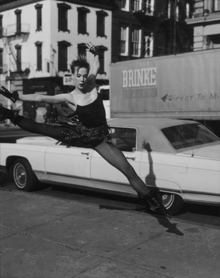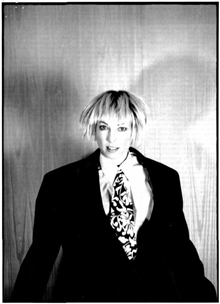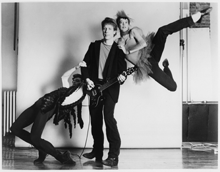|
By Dave Kim The typical ballet doesn't open with an eight-foot-tall inflatable pig and a pregnant woman in a tutu. But tonight they're here, a handsome fabric swine created by Jeff Koons and its lover, the stunning Megumi Eda, who, despite her eighth-month bulge, flirts, stretches, and swoons with deadpan poise. They dance coyly, as if in love. Accompanying the touching pas de deux is a Kronos Quartet recording paying tribute to the 1970's Mexican sitcom, El Chavo del Ocho, complete with whistles and Chuck Jones-inspired boioioings. It's over before one can assess it further than, "Hey, this is cool": dancers bow, a Dadaist somewhere giggles, curtain. On to Act II. Karole Armitage hasn't done a typical ballet in decades, though she |
insists that there's no break between her work and the classical ballet she learned as a girl. The continuum, as she calls it, between old and new
 has just taken unexpected turns over the years. In the eighties, she was famously dubbed the "punk ballerina" for her collaborations with |
Rhys Chatham and the New York underground scene. Vanity Fair called her "the high
priestess of punk choreography" in 1986, publishing a very anti-Degas photograph of a young, punked-out Armitage doing a mid-air split somewhere in the East Village (in front of an El Dorado hooptie to boot).
Her signature blond spikes were spikes then, her ballets, laced with loud guitars, stilettos, and a bristling sexual energy you might've felt in Nutcracker—the S&M club uptown. But those in the know could spot the classicist—a conflicted one—through all the eye makeup and frank eroticism. Her most notorious punk-ballet mash-up, Drastic Classicism (1981), was ballet in both the loosest and purest sense of the word. Armitage preserved the five hundred-year-old tradition's movements and forms but discarded its image, making the classical ballerina over as a Sex Pistols groupie, a rogue in black leather pointe shoes. The discipline and body restraint were still there, bashing heads with |
Mohawk-ed rebellion and rock 'n' roll. Since then, Armitage has experimented with plenty of different artists and musical styles. Her roster of artistic collaborators and featured music is a long and varied one; Charles Mingus, Brice Marden, Jeff Koons, Frank Zappa, Madonna, Michael Jackson, Public Enemy, Béla Bartók, Jean Paul Gaultier, Christian Lacroix, and longtime collaborator David Salle are just a few. Most people can't even put Zappa and ballet in the same sentence. "I love the tension of tremendous contradiction," says Armitage. "Art is really about unexpected combinations, the bringing together of opposites." In her latest creation, Ligeti Essays, a collection of twenty-three movement poems based on the work of the late composer György Ligeti, opposing forces are made to negotiate, so that the work seems at once conflicted and integrated. The dancers' movements are fluid but punctuated by sharp outbursts and freezes, which I'm told is very |
un-ballet. Man and woman, white and black, short and tall, all dressed in dark velour leotards, weave, push, and drag one another to atonal,
 often mechanistic music. (Kubrick was a big fan of Ligeti and used his |
music in 2001: A Space Odyssey, Eyes Wide Shut, and Full Metal Jacket.)
David Salle's lone silver tree stands behind them, leafless and frozen in its own severe arabesque, and long neon bars glow eerily from the stage floor. The visuals are wintry and
austere, the contrasts stark and unruly. But then the stage lights dim, slowly, almost imperceptibly, revealing a starry night sky. The stage becomes a pond in winter and suddenly the cold minimalism becomes welcoming, the rough edges soften. It's in this fluid, evolving space where sacrifice, betrayal, camaraderie, and other themes are explored and repeated. There's no story to follow, only metaphors. It's wonderful to watch but not an easy performance in any sense. Which is fine because Armitage thrives on difficulties and on being one. This is a woman who started dancing seriously at the age of five, who worked hard to gain entry to and then left world-famous dance companies mid-career, who once |
hiked a 12,000-foot mountain pass to go to ballet school in Aspen, who choreographed acclaimed music videos and then chose to stay the pauper in modern dance, whose idea of a relaxing getaway is backpacking through Laos and Cambodia. It took her a while to find her niche. After graduating from North Carolina School of the Arts, Armitage became a member of the Geneva Ballet under dance icon George Balanchine. She has hearkened back to Balanchine's techniques in many, perhaps all, her works since, but classical ballet by itself wasn't enough.
"I felt after a little while that I was kind of an imposter in a tutu," she recalls. "I just couldn't understand those imperial manners." Armitage was introduced to "the modern stuff" when she joined Merce Cunningham's dance company in 1976, but after two years even "leotard ballets" and contemporary dance seemed passé. In 1978, Armitage created her first piece, Ne, with early punk band The The. Later, Vertige (1980) and the now legendary Drastic |
Classicism (1981), both made with Rhys Chatham, confirmed her status as New York's punk ballerina. Then
 the offers came pouring in, from music video directors, from Europe, from Baryshnikov. There were good and bad reviews; some were floored by Armitage's marrying of the traditional forms she'd practiced all her life and the counterculture she loved. Others called her a sensationalist. Not even Karole knew exactly what she was doing. "I was curious. I didn't have a plan or even think, 'I'm gonna be a |
choreographer'—it was an experiment. It just kind of happened, in a very un-structured way." Every move in tonight's performance has been meticulously planned at some point in Armitage's packed rehearsal schedule. ("Yoga at seven-thirty. Then to the dance studio from ten to twelve to work on dance phrases. Then lunchtime—there's no lunchtime, there's no eating—from twelve to six is rehearsal. And then six to ten is administration. Dance is very, very practical. You've got the body—now how does it move? You can't cheat.") Still, there's something about the movements that seem improvised at times, in the tension and sudden switch from potential to kinetic energy, in the asynchronous assemblies of bodies. It's most apparent in the third part of the show, an adaptation of a ballet Armitage created in 2004 called Time is the Echo of an Axe Within a Wood. David Salle's glittering backdrop, a curtain of silver strings that wraps around the entire stage, is perfect: a |
seemingly rigid form that's disordered and made fluid with the slightest touch. I feel like I'm inside a cubist harp; at one point a dancer even runs along the back wall of the stage, strumming a silent arpeggio. When there are several dancers on stage at once they move independently, with a precise and intentional irregularity. It's a refreshing change from the militant sync and symmetry of musicals, pop music videos, and, well, Fascists. Individuality is spared, even celebrated. If only the same could be said for the country. "American culture has changed enormously, in ways that make it much harder to work in dance," Armitage argues. "Back then there was punk, there was a place for things that were marginal. Now everything's much more homogenized and controlled by corporate mentality. You know, unless you're just some weirdo like me who's still trying to do this." Sitting in a kitchenette backstage after a matinee performance of Ligeti |
Essays, the Lawrence, Kansas-native certainly doesn't look like a weirdo in a gray sweater, black warm-ups, and
 running shoes. Only her red plastic glasses and messy blond spikes distinguish her from the average woman in the audience. But there's a chip on her shoulder. After punk fizzled in the U.S., Armitage left for Europe, attracted by offers of creative |
freedom and tired of the American obsession with entertainment and celebrity culture. She dabbled in pop, choreographing music videos for Madonna and Michael Jackson. It wasn't "real" dance to her though, but more about furthering others' careers and selling products. "There was a time when I thought pop might be a useful tool to acquaint an audience with what you were doing," she muses. "But now I think it's so all-powerful and overly present that we should do the exact opposite, do something completely unique and rare and special. Let the pop people do pop—they do it better than we could anyway." Armitage hasn't had much time to inspect the latest stuff—krumping had a moment—and she doesn't have cable either. For someone who can't stand the fact that there's nothing new in American pop culture that sustains her interest, who's on the cutting edge of her own medium, Armitage loves ancient and medieval ideas. In another lifetime, she says, she'd be a Classics scholar. She's read |
"everything from Sutonious to Satyricon," books on Roman culture, the Renaissance, "all of Machiavelli, all of Dante." If the New World can't offer anything artistically noteworthy then maybe the Old World can. "Look what's happened," she says with a sigh. Everything co-opted by commercialism, banality everywhere. There may be something fresh out there, she hopes, but she's not sure what it is or where to find it. Even hip-hop and breakdancing, once one of her favorite styles of dance, has gone commercial. "It was so virtuosic. The values were about incredible control of the body, beautiful phrasing, musicality, being very cool and pulling it off like it was effortless—everything about it was just like classical ballet." Her next two projects, as expected, are nothing alike. One is an exploration of black holes, an idea sparked while reading Brian Green's The Elegant Universe. The other is an ecological piece inspired by Audubon's Birds of America. With the former, |
Armitage explains, after a dizzying lecture on quantum theory and the theory of relativity, that she hopes to
 explore the incompatibility of scientific data when dealing with black holes. She insists the Birds |
piece is a hopeful work, citing the recent discovery of the ivory-billed woodpecker once thought extinct, "but with the implication that we need to take care." Astrophysics and environmentalism. Remember, she does ballet. Again we meet Karole Armitage, woman of unexpected combinations. Times and audiences may have changed for the punk ballerina, a title, by the way, that she hasn't grown tired of ("I only wish it were more appropriate now"), but her obsession with marrying contrasts hasn't. She's still fighting mainstreamism, corporate culture, and banality; only she's retired her shredded tartans and stiletto heels. The title just needs to be reinvented into something that invokes the same philosophy but is more suited for the day. I ask her if she has any suggestions. "No," she says, with a dismissive gesture. "That's your job." |
©2006 Smyles & Fish
